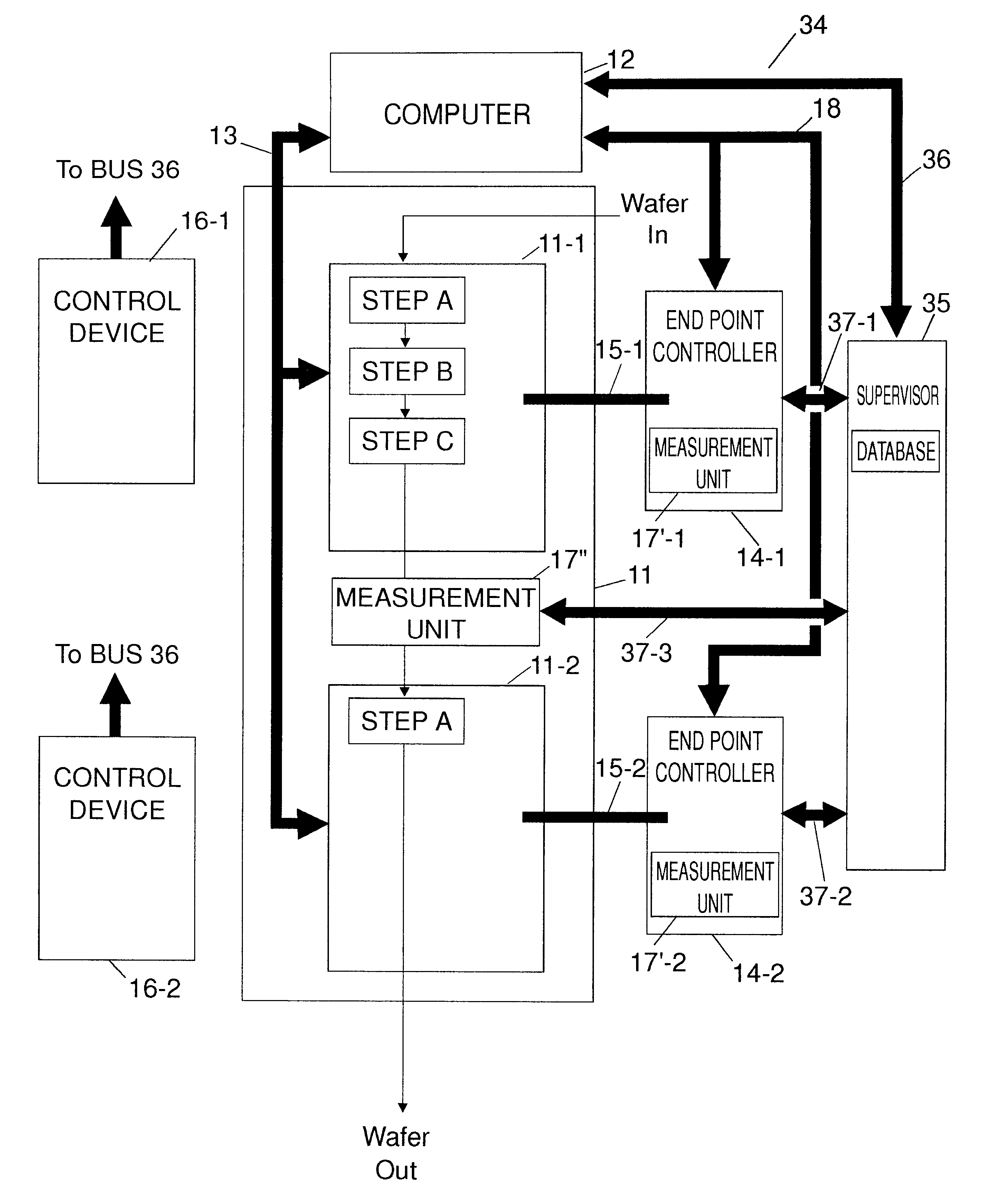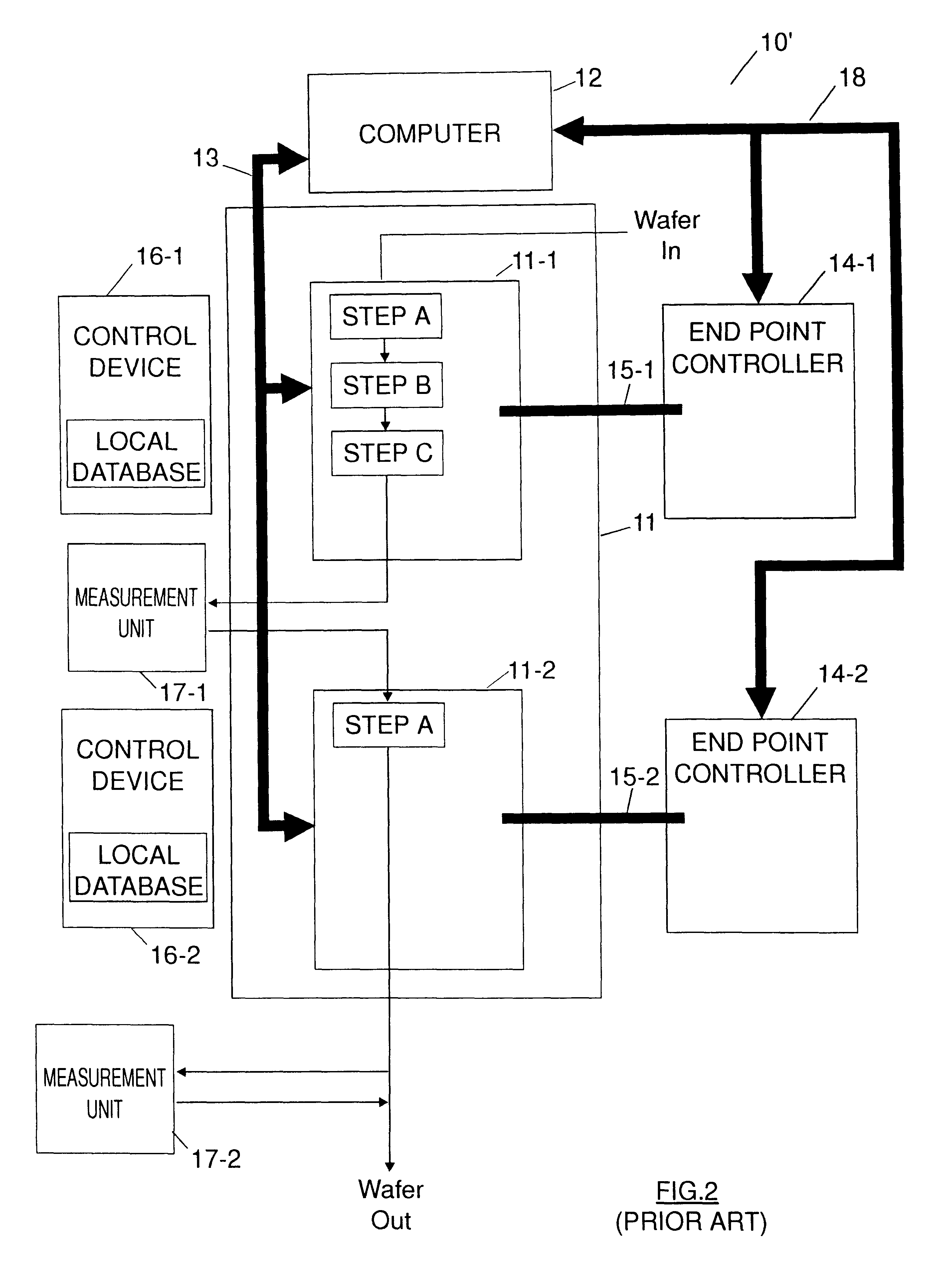Method and system for semiconductor wafer fabrication process real-time in-situ interactive supervision
a technology of real-time semiconductor wafers and fabrication processes, applied in semiconductor/solid-state device testing/measurement, instruments, photomechanical equipment, etc., can solve the problems of increasing the number of processing tools required to achieve the effect of achieving real-time status of semiconductor wafers after each processing step, avoiding unnecessary processing time and wafer waste, and speeding up wafer processing
- Summary
- Abstract
- Description
- Claims
- Application Information
AI Technical Summary
Benefits of technology
Problems solved by technology
Method used
Image
Examples
example i
As mentioned above, at the initial stage of the "AB ETCH" process, i.e. step A, photoresist layer AB1 is normally present. The case where structure 19 has no defect is represented by curves 26 to 29 in the graph of FIG. 4. As apparent from FIG. 4, the derivative signal S'1 (curve 27) exhibits a very sharp transient at the end of the step. Now turning to FIG. 8 which illustrates the signals 31, S'1, S2 and S'2 when the AB1 photoresist layer 24 is missing. In this case, the S'1 signal represented by curve 34 has a more gradual slope instead. This difference will be used by the expert information to distinguish the two cases. To characterize the absence of the AB1 photoresist layer, the following rule has been established: if signal S'1 is higher than 500 (arbitrary units) and lower than 1600 during at least about 25 s, the AB1 photoresist layer is considered missing. Then, the consequence of such a situation is considered for an appropriate response. If AB1 photoresist layer is missin...
example ii
Let us assume that the wafer has not been submitted to the AB1 lithography step. As a result, the two photoresist AB1 and AB2 layers 24 and 25 are present in their totality at the surface of the structure 19 before the wafer is processed at step A. FIG. 9 shows signals S1, S'1, S2 and S'2 in that particular situation. In this case, expert information provides selected signal S'2 of curve 35 which defines the etch rate and thus the etched thickness. The rule specifies that if etched thickness exceeds 10% of the nominal value, the process should be stopped, otherwise it will continue until the maximum allowed time be reached. Because, the etch end point of step A will never occur, the TEOS SiO2 layer 22 will never be etched, this is why the etch process must thus stop without delay. The alert code will be again "IMMEDIATE STEP STOP" and the recommended action is to by-pass steps B and C. In the instant case, the wafer is not damaged, it just needs to be reworked.
example iii
Still another frequent failure that occurs in the manufacturing at the "AB ETCH" level is the absence of the AB2 photoresist layer 25. If AB2 photoresist layer 25 is missing when step A is initiated in chamber 11-1, the chemistry that is currently used at this step, etches both the TEOS SiO2 material of layer 22 and the photoresist material of AB1 layer 24 at the same rate. In a few minutes, the totality of the AB1 photoresist is removed plus a large amount of the TEOS SiO2 material. As a consequence, the wafer needs to be rejected at this stage of the fabrication process. In this case, signal S'1 will be used, and as soon as an interference is detected, which means that TEOS SiO2 material is being etched, the etching is immediately stopped. FIG. 10 shows signals S1, S'1, S2 and S'2 in that particular situation, wherein signal S'1 is represented by curve 36. In this case, the rule is: starting from RATE TIME RT of signal S'1 for a maximum duration of 120 s, if signal S'1 amplitude r...
PUM
| Property | Measurement | Unit |
|---|---|---|
| thickness | aaaaa | aaaaa |
| thick | aaaaa | aaaaa |
| wavelength | aaaaa | aaaaa |
Abstract
Description
Claims
Application Information
 Login to View More
Login to View More - R&D
- Intellectual Property
- Life Sciences
- Materials
- Tech Scout
- Unparalleled Data Quality
- Higher Quality Content
- 60% Fewer Hallucinations
Browse by: Latest US Patents, China's latest patents, Technical Efficacy Thesaurus, Application Domain, Technology Topic, Popular Technical Reports.
© 2025 PatSnap. All rights reserved.Legal|Privacy policy|Modern Slavery Act Transparency Statement|Sitemap|About US| Contact US: help@patsnap.com



